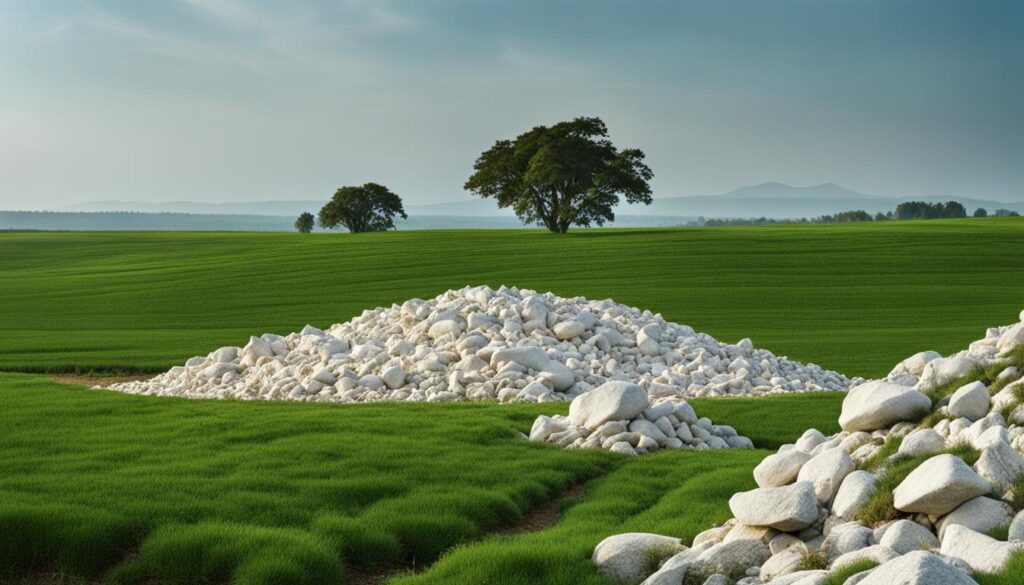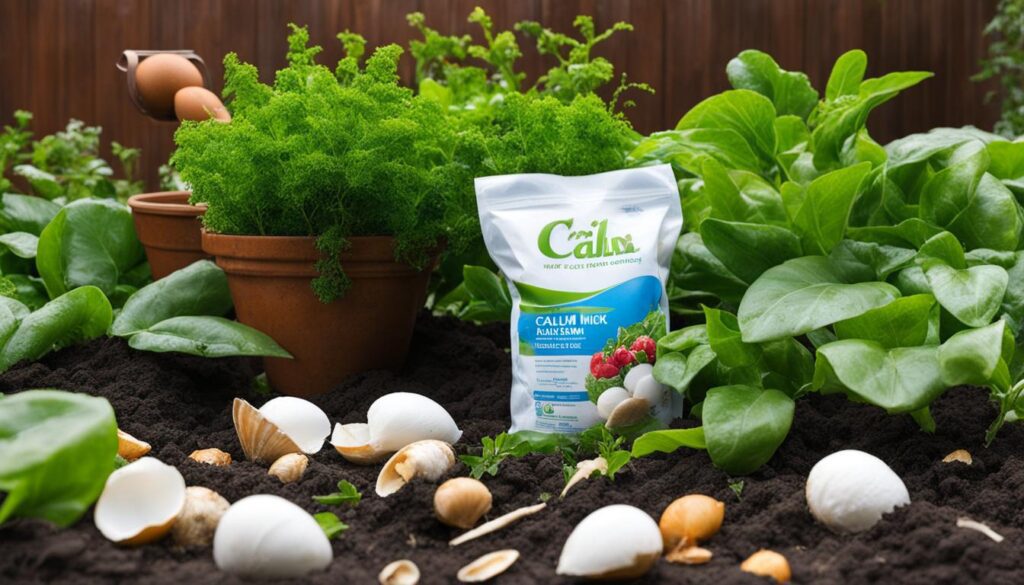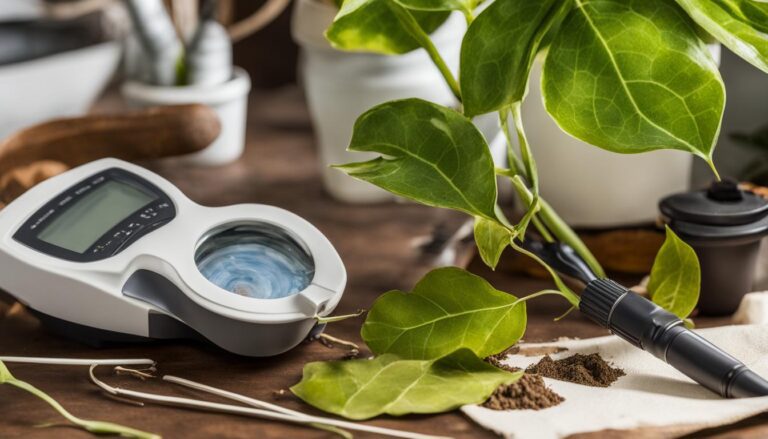
Adding calcium to your plants is essential for their overall health and growth. In this comprehensive guide, I will explore various methods and techniques to effectively add calcium to your plants.
We will discuss plant calcium supplements, natural sources of calcium, the benefits of calcium for plants, how to address calcium deficiency in plants, and the different ways to add calcium to soil, including using calcium foliar sprays and calcium-rich fertilizers.
Let’s dive in and unlock the secret to healthier, more robust plants!
Key Takeaways:
- Adding calcium to plants is crucial for their health and growth.
- Plant calcium supplements, natural sources, and fertilizers are effective ways to provide calcium to plants.
- Calcium plays a vital role in plant growth, including strong cell wall formation and disease resistance.
- Recognizing calcium deficiency symptoms in plants is essential for timely supplementation.
- Calcium can be added to soil through limestone, bone meal, compost, or gypsum.
The Importance of Calcium for Plants
Calcium is an essential element for the growth and development of plants. It plays a vital role in various physiological processes, contributing to their overall health and vigor.
One of the key functions of calcium in plants is the formation of strong cell walls. Calcium provides structural support, ensuring that plants grow upright and have the necessary strength to withstand environmental stressors.
Calcium enhances disease resistance in plants, making them less susceptible to infections and pest attacks.
Strong cell walls are essential for plants to maintain their structure and integrity. Calcium helps in the formation and stabilization of pectin, a component of cell walls.
This strengthens the cell structure, ensuring that plants can withstand external pressures and maintain their shape. The presence of an adequate amount of calcium in the cell walls also facilitates the movement of water and nutrients within the plant, promoting efficient growth and development.
In addition to supporting plant structure, calcium plays a crucial role in disease resistance. It activates various defense mechanisms, strengthening the plant’s immune system.
Calcium ions are involved in the signaling pathways that trigger the production of defense compounds, such as phytoalexins, antimicrobial proteins, and pathogenesis-related proteins.
This helps plants combat pathogens and defend against diseases, contributing to their overall health and longevity.
The Role of Calcium in Plant Growth
| Aspect | Effects of Calcium |
|---|---|
| Cell wall formation | Strengthens cell walls, providing structural support and upright growth |
| Disease resistance | Enhances plant’s immune system, reducing susceptibility to infections and pests |
| Water and nutrient uptake | Aids in the movement of water and nutrients within the plant for efficient growth |
Overall, calcium is an essential nutrient for plants, playing a crucial role in their growth, development, and resilience. By understanding the importance of calcium and its functions in plant physiology, we can make informed decisions regarding calcium supplementation to ensure optimal plant health and productivity.
The sequel follows….
Calcium deficiency in plants can have detrimental effects on their growth and overall health. Recognizing the signs of calcium deficiency in plants is crucial for timely intervention and supplementation.
Some common symptoms of calcium deficiency include stunted growth, curling of young leaves, brown spots on leaves, inhibited bud growth, chlorosis, burnt leaf tips, and fruit damage such as blossom end rot in tomatoes.
To provide the necessary supplementation and address calcium deficiency in plants, it is important to identify these symptoms and take appropriate action.
By recognizing the signs of calcium deficiency, gardeners can ensure that their plants receive the necessary nutrients to thrive.
The table below provides an overview of the signs of calcium deficiency in plants, including specific symptoms and their effects on various plant species:
| Plant Species | Symptom | Effect |
|---|---|---|
| Tomatoes | Blossom end rot | Damaged fruit, leading to reduced yield |
| Lettuce | Tipburn | Browned leaf tips, reducing overall quality |
| Apples | Bitter pit | Dark spots on fruit skin, affecting marketability |
By staying vigilant and monitoring the health of your plants, you can identify signs of calcium deficiency early on and take the necessary steps to address the issue. This will help ensure that your plants receive the essential nutrients they need to grow and thrive.
Natural Sources of Calcium for Plants
When it comes to supplementing your plants with calcium, there are several natural sources that can provide this essential nutrient. These sources are easily accessible and can be incorporated into your gardening routine to promote healthy plant growth.
Using Eggshells for Calcium
Eggshells are a great natural source of calcium for plants. They can be ground into a fine powder and added to the soil or used as a calcium solution for plants. The calcium in eggshells helps strengthen cell walls and promotes overall plant health.
Crushed Oyster Shells for Calcium
Crushed oyster shells are another excellent source of calcium for plants. Not only do they provide calcium, but they also contain micronutrient minerals that are beneficial for plant growth. Incorporating crushed oyster shells into the soil can improve calcium levels and support plant development.
Using Wood Ash as a Calcium Supplement
If you have wood ash from burning wood, it can be used as a calcium supplement for plants. Wood ash is rich in calcium carbonate and can help raise soil pH levels. However, it’s important to use wood ash in moderation as excessive amounts can disrupt the pH balance of the soil.
| Natural Source | Benefits |
|---|---|
| Eggshells | • Provides calcium for strong cell walls • Promotes overall plant health |
| Crushed Oyster Shells | • Supplies calcium and micronutrient minerals • Supports plant growth |
| Wood Ash | • Contains calcium carbonate • Helps raise soil pH levels |
By utilizing these natural sources of calcium, you can ensure that your plants receive the necessary nutrients for their optimal growth and development. Remember to use these sources in moderation and consider conducting a soil test to determine the appropriate supplementation required for your specific plants.
Adding Calcium to Soil for Plants

To ensure optimal growth and health of your plants, it is essential to provide them with an adequate supply of calcium. Adding calcium to soil can be done through various methods and using different substances. Here are some effective options:
1. Limestone
Limestone is a popular choice for increasing soil calcium levels. It is rich in calcium carbonate and can help raise the pH of acidic soils.
By incorporating limestone into the soil, you can improve nutrient availability and promote healthier plant growth. It is recommended to conduct a soil test to determine the appropriate amount of limestone needed for your specific soil conditions.
2. Bone Meal
Bone meal is another excellent source of calcium for your plants. It is a slow-releasing fertilizer that provides a steady supply of nutrients, including calcium.
By adding bone meal to the soil, you can enhance calcium levels and promote strong root development. Bone meal is particularly beneficial for plants that require a continuous supply of calcium over a longer period.
3. Compost
Utilizing compost in your garden not only enriches the soil with organic matter but also contributes to soil calcium levels.
As compost breaks down, it releases essential nutrients, including calcium, which can be readily absorbed by plants. Adding compost to your soil is a sustainable and natural way to increase calcium availability and support plant growth.
4. Gypsum
Gypsum is a naturally occurring mineral that can be used to increase soil calcium levels. It is commonly used to improve soil structure and drainage.
Gypsum can enhance calcium availability and help address calcium deficiency in plants. Applying gypsum to your soil can improve overall soil health and promote optimal nutrient absorption by plants.
| Method | Benefits | Considerations |
|---|---|---|
| Limestone | Raises soil pH, improves nutrient availability | Ensure proper dosage based on soil test results |
| Bone Meal | Slow-releasing source of calcium, promotes strong root development | Use for plants that require a continuous supply of calcium |
| Compost | Increases soil calcium levels naturally, enriches soil with organic matter | Use high-quality compost free from contaminants |
| Gypsum | Improves soil structure and drainage, enhances calcium availability | Apply gypsum based on soil analysis and recommendations |
By incorporating these methods into your gardening routine, you can effectively add calcium to soil and ensure your plants receive the essential nutrient they need for optimal growth and productivity.
Calcium Foliar Spray for Plants
Adding calcium to your plants through a foliar spray is an excellent way to provide them with a quick and effective dose of this essential nutrient. Calcium foliar sprays offer numerous benefits for plant health and can be easily incorporated into your gardening routine.
Benefits of Calcium Foliar Spray:
- Preventing and correcting calcium deficiency: Calcium foliar sprays can address calcium deficiency symptoms in plants, such as stunted growth and blossom end rot.
- Improving overall plant health: Adequate calcium levels promote strong cell walls, disease resistance, and enhanced nutrient uptake in plants.
- Enhancing fruit quality: Calcium foliar sprays can improve the texture, taste, and shelf life of fruits.
You can make your own calcium foliar spray using accessible ingredients. One popular method is to create a solution using eggshells or crushed oyster shells.
To make the spray, crush the shells into a fine powder and mix them with water. Allow the mixture to sit for a few days, then strain it and transfer it to a spray bottle. You can then apply the homemade calcium foliar spray directly onto the leaves of your plants.
Commercial Calcium Foliar Spray:
If you prefer a convenient and ready-to-use option, there are various commercial calcium foliar sprays available in the market.
These sprays are formulated specifically for plant absorption and provide a concentrated source of calcium. Follow the instructions on the product label for application rates and frequency to ensure optimal results.
| Calcium Foliar Spray Options | Pros | Cons |
|---|---|---|
| Homemade Calcium Foliar Spray | Cost-effective, customizable, uses easily available ingredients | Requires preparation time, may have a shorter shelf life |
| Commercial Calcium Foliar Spray | Convenient, formulated for plant absorption, precise application instructions | May be more expensive, limited customization options |
Whether you choose to make your own calcium foliar spray or opt for a commercial product, incorporating this method of calcium supplementation can help ensure optimal calcium levels in your plants, leading to healthier and more robust growth.
Calcium-Rich Fertilizers for Plants

When it comes to providing plants with a concentrated supply of calcium, there are several options available in the form of calcium-rich fertilizers. These fertilizers offer a convenient and efficient way to increase calcium levels in the soil and support healthy plant growth.
Water-Soluble Calcium Fertilizers
Water-soluble calcium fertilizers, such as those containing calcium nitrate or calcium chloride, can be dissolved in water and applied directly to the soil. These fertilizers provide a quick and immediate supply of calcium to the plants, promoting strong cell walls and overall plant health.
Lime as a Calcium Fertilizer
Lime is a commonly used calcium fertilizer that not only provides calcium but also helps raise soil pH levels. By increasing soil pH, lime improves the availability of calcium to plants, ensuring they receive an adequate supply of this essential nutrient. Lime can be applied as a powder or pellet and incorporated into the soil.
Organic Calcium Fertilizers
For organic gardening enthusiasts, there are several options for organic calcium fertilizers. Compost and organic bone meal are excellent sources of calcium and can be incorporated into the soil to increase calcium levels naturally. These organic fertilizers not only provide calcium but also contribute to overall soil health and fertility.
| Calcium-Rich Fertilizers | Benefits |
|---|---|
| Water-soluble calcium fertilizers | Provide quick and immediate calcium supply to plants Promote strong cell walls and overall plant health |
| Lime | Raises soil pH and improves calcium availability Provides a concentrated supply of calcium |
| Organic calcium fertilizers (compost, organic bone meal) | Increase calcium levels naturally Contribute to overall soil health and fertility |
By incorporating calcium-rich fertilizers into your plant care routine, you can ensure that your plants receive the necessary supply of calcium for optimal growth and vitality.
Best Practices for Adding Calcium to Your Plants
When it comes to adding calcium to your plants, following a few key tips can make all the difference in promoting their overall health and vitality. Here are some best practices that I recommend:
1. Test Your Soil: Before adding any calcium supplements, it’s important to know the current calcium levels in your soil. A professional soil test can provide valuable insights and help you determine the appropriate amount of supplementation needed.
2. Optimal Calcium Levels: Different plants have varying calcium requirements, so it’s essential to understand the optimal calcium levels for the specific plants you are growing. This information can be found through research or by consulting with gardening experts.
3. Importance of Soil Testing: Regular soil testing is crucial to monitor and maintain the calcium levels in your soil. It allows you to adjust your supplementation strategy and ensure that your plants receive an adequate supply of calcium throughout their growth stages.
4. Correct Timing and Form: Timing and form matter when it comes to adding calcium to your plants. Some plants benefit from a specific form of calcium supplementation, such as using foliar sprays during flowering or incorporating calcium-rich fertilizers during the planting stage. Understanding the requirements of your plants will help you make the right decisions.
By adhering to these best practices, you can effectively add calcium to your plants and provide them with the necessary nutrients for optimal growth. Remember, maintaining optimal calcium levels in your plants is essential for their overall health and resilience against nutrient deficiencies and diseases.
FAQ
How do I determine if my plants have calcium deficiency?
Look for signs such as stunted growth, curling of young leaves, brown spots on leaves, inhibited bud growth, chlorosis, burnt leaf tips, and fruit damage like blossom end rot in tomatoes.
What are some natural sources of calcium for plants?
You can use eggshells, crushed oyster shells, and wood ash as calcium supplements for your plants.
How can I add calcium to soil for plants?
You can use limestone, bone meal, compost, and gypsum to increase soil calcium levels.
How can I provide calcium to my plants through foliar sprays?
You can make homemade calcium foliar sprays using eggshells or purchase commercial options. Spray the solution directly on the leaves for quick absorption.
What are some calcium-rich fertilizers for plants?
Water-soluble calcium fertilizers like calcium nitrate or calcium chloride, lime, and organic options like compost or organic bone meal are all effective sources of calcium.
What are some best practices for adding calcium to plants?
It’s recommended to test your soil’s calcium levels, maintain the right pH level, and apply calcium at the right time and in the correct form for optimal results.





